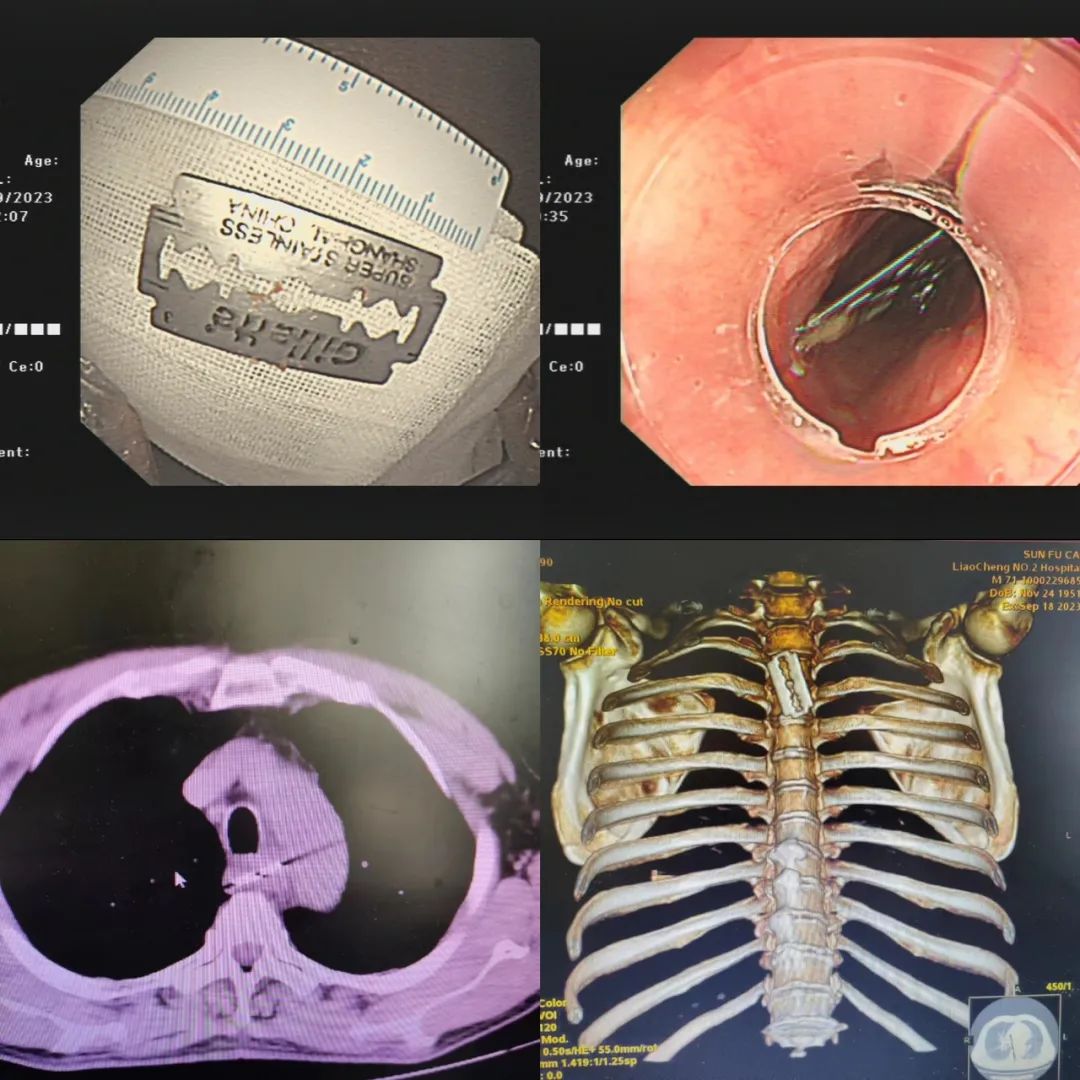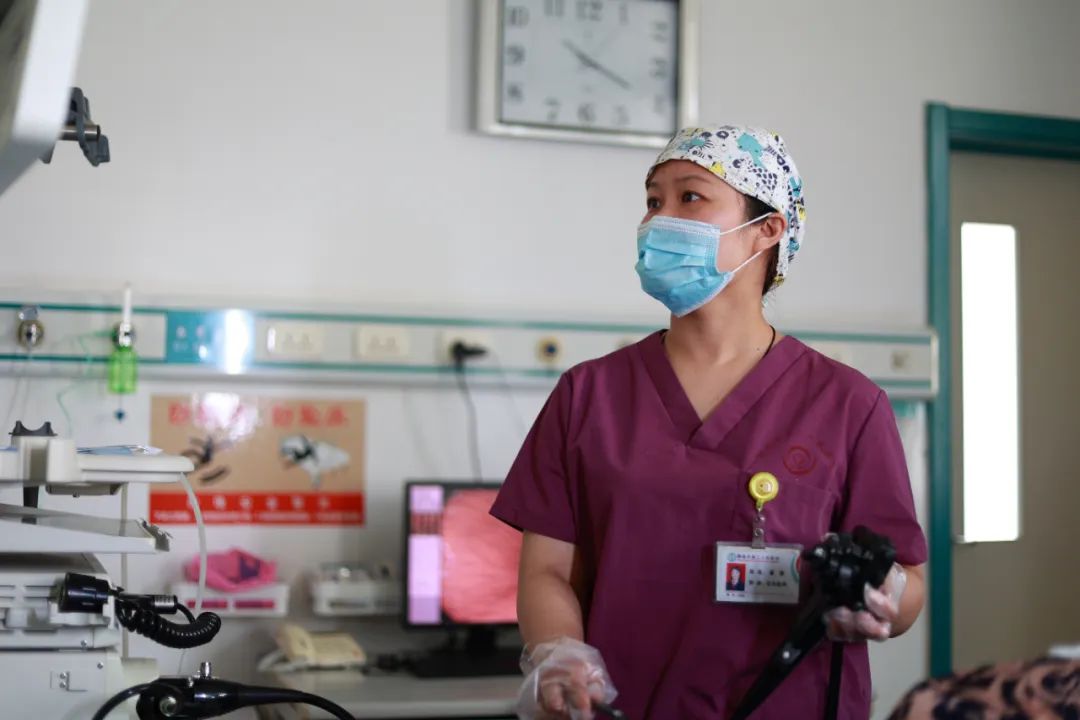- Date:2023-09-27
- Click:5403Times
The morning of September 18, Liaocheng City Second Hospital, gastrointestinal endoscopy room as usual in a tense and orderly busy, near the end of the day, suddenly broke into a patient's family members, shouting "Doctor, help! The patient's family suddenly broke into the room, shouting "Doctor, help! On hearing the news, Dr. Zhai Wei of the Division of Gastroenterology put down his work at hand and rushed over, only to see the person holding a chest CT slice, a razor blade standing in the center of the esophagus, the sharp blade is facing the arch of the aorta, and the distance from the aorta is only about 3mm, and the aorta is pulsating with the heart, the razor blade at any time there is a risk of penetrating the esophagus, cutting the aorta, and the patient's life safety is seriously threatened! The patient's life was seriously threatened!

The patient was pushed to the scene by his family in a wheelchair. It turned out that the patient is a 70-year-old man, his family birthday with a razor to cut open the cake packaging, the razor accidentally fell into the cake, the old man swallowed by mistake, and three days later the old man felt pain in swallowing, to the hospital for examination, was found to be a razor blade.
Dr. Zhai Wei immediately explained the patient's condition to his family, explaining the necessity of removing the foreign body from the esophagus and the various risks, especially the double-edged razor blade, which is very easy to cause secondary damage when removing it, and the family members expressed their understanding and signed the letter. At the same time, Director Yue Zongzhu organized anesthesiologist Sheng Chen, endoscopy room nurse Jin Yan and the nursing team to make all kinds of preoperative preparations, and all of them were on standby.

The foreign object in the esophagus was a sharp blade and was so close to the aorta, so the surgical process required a high level of psychological tolerance and stability of the lens. Dr. Zhai Wei held the scope steadily and carefully clamped the foreign body, constantly adjusting the direction of the blade and smoothly removing it along the esophagus. The whole process was slow and delicate. The moment the blade was removed from the patient's mouth, everyone was relieved and there was a round of applause.
However, this is not the end, how is the patient's esophagus? Zhai Wei once again extended the digestive endoscope into the patient's esophagus to observe and assess the damage caused by the blade to the esophagus, and found that the deepest part of the blade had fractured the muscularis propria, with a length of about 2cm, and there was freshly oozing blood. Zhai Wei used titanium clips to close the wound and rinsed the wound, observing that there was no active bleeding on the wound, and then she breathed a sigh of relief. The patient woke up and was sent back to the ward for hospitalization.
RELATED:
Foreignbodies in esophagus (foreignbodies in esophagns) are mostly seen with the elderly and children. Elderly people are prone to swallowing foreign bodies due to loss of teeth or use of dentures, poor chewing function, lack of sensitivity of intraoral sensation, and looseness of the esophageal orifice; children are more likely to swallow foreign bodies due to playthings in their mouths. In addition, esophageal stenosis or esophageal cancer is also a common cause of foreign bodies in the esophagus.
Types of foreign bodies:
1. Animal most common, such as fish spines, chicken bones, chicken meat, meat pieces and so on;
2. metallic, such as gold necklaces, coins, pin nails, dentures, bottle caps, etc;
3. chemical and plant-based, lighters, date palms, rice balls, etc.
Improper treatment and untimely can cause; 1. esophageal perforation or injurious esophagitis.
4. subcutaneous neck emphysema or mediastinal emphysema.
5. Peresophagitis and cervical hiatus infection or mediastinitis.
6. Large blood vessel rupture.
7. tracheoesophageal fistula.
Clinical manifestations:
1. foreign body obstruction: if the foreign body in the cervical esophagus, the symptoms are more obvious, the patient can usually point out that the foreign body in the upper sternal fossa or the lower neck; if the foreign body in the thoracic esophagus, there can be a sense of obstruction of the posterior sternal foreign body.
2. Pain: Pain often indicates the degree of damage to the esophageal wall caused by the foreign body. Heavier pain is a signal that the foreign body is damaging the esophageal muscularis propria and should be taken seriously. Usually, a smooth foreign body is a dull pain, while a sharp-edged and pointed foreign body is a severe sharp pain. Injury to the esophageal mucosa is often a persistent pain that worsens paroxysmally with swallowing movements. Sometimes the most intense pain may suggest the site of the foreign body but its localization accuracy is limited.
3. Dysphagia: Dysphagia is related to the degree of esophageal obstruction caused by the foreign body. Individuals with mild dysphagia, or even without any symptoms, may carry the disease for months or years and delay treatment.
4. Respiratory symptoms: mainly manifested as dyspnea, cough, cyanosis and other symptoms. Mostly occur in infants and young children, especially in the entrance of the esophagus and the upper esophagus of the foreign body.
5. When the foreign body is large or sharp, it can compress the larynx or damage the mucosa and cause inflammation. If the esophagus is punctured and causes secondary infection, it can lead to peri-esophageal inflammation, abscess, hemorrhage, mediastinitis, mediastinal abscess, as well as other inflammation of soft tissues in the neck.
6. Inadequate intake due to mechanical obstruction may lead to dehydration, malnutrition, acidosis, etc.
How to deal with it?
1, suspected foreign body stuck in the esophagus should be immediately prohibited from drinking, fasting, go to the hospital for medical treatment, do not use steamed bread, vinegar to swallow, will aggravate the scratch! Do not use your hands to pick, vigorously vomit, may lead to bleeding.
2, should be as soon as possible to the gastroenterology, emergency, otorhinolaryngology, as clearly as possible to inform the doctor of the type of foreign body, the time of swallowing, as well as self-consciousness tingling sensation of the most obvious parts. Complete laryngoscopy or cervical/thoracic CT examination to clarify the foreign body.
3. In the past, the removal of esophageal foreign body mainly relied on surgery, but with the development of gastrointestinal endoscopy, gastroscopic removal of foreign body has become the preferred method of treatment of esophageal foreign body due to its simple operation, few complications and high success rate.
4. The prolonged embeddedness of foreign bodies in the esophagus will lead to more complications, and the success rate of removal will also decrease, so we should fight for time to treat it as early as possible. Especially toxic or sharp foreign bodies should be removed as early as possible.



 鲁ICP备11009722号-4
鲁ICP备11009722号-4 